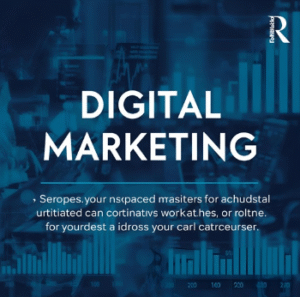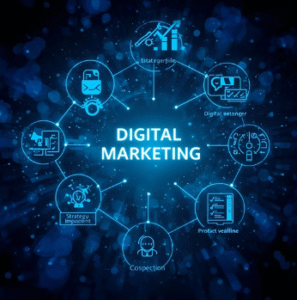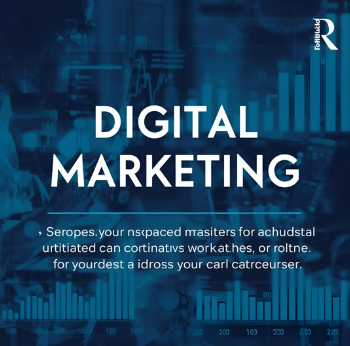Introduction to Digital Marketing
Digital marketing has become an integral part of modern business, offering innovative ways to connect with customers and achieve measurable results. It encompasses a variety of strategies, all designed to promote products or services through digital channels. From small startups to large corporations, businesses are leveraging digital tools to remain competitive in a market that increasingly operates online.
One of the key aspects of digital marketing is its versatility. Unlike traditional marketing, it allows for real-time adjustments and highly targeted campaigns. Businesses can reach specific demographics based on factors such as location, age, interests, and online behavior. This level of precision makes digital marketing a cost-effective solution for companies looking to optimize their advertising efforts.
A strong online presence is essential for success in today’s marketplace. This includes maintaining an engaging website, participating in relevant social media platforms, and consistently providing value to your audience. Each of these components works together to help establish your brand, build trust, and encourage customer loyalty.

Additionally, the data-driven nature of digital marketing sets it apart. Analytics tools provide valuable insights into campaign performance, helping businesses identify what works and what doesn’t. By analyzing these metrics, marketers can refine their strategies to achieve better outcomes over time.
To make the most of digital marketing, it’s important to stay informed about emerging trends and technologies. Changes in consumer behavior and platform updates can quickly shift the way businesses approach their strategies. Adapting to these changes ensures your brand remains relevant and continues to meet the needs of your audience.
Successful digital marketing requires a balance of creativity, strategy, and analysis. Crafting compelling messages, understanding your audience, and utilizing the right tools can help your business thrive in an increasingly digital world.
Search Engine Optimization (SEO) Basics
Search Engine Optimization (SEO) is all about making your website more accessible and appealing to both users and search engines. At its core, SEO focuses on improving the quality and relevance of your website’s content while enhancing its technical performance. By doing so, your site is more likely to appear prominently in search results when users look for topics related to your business.
One important element of SEO is keyword research. Identifying the terms and phrases your audience is searching for helps guide the content you create. Incorporate these keywords naturally into your site’s pages, headings, and metadata to signal to search engines that your site provides valuable information on those topics. However, avoid overloading your content with keywords, as this can negatively impact your rankings.
Another critical aspect is on-page optimization. This involves structuring your content in a way that is easy to read and understand. Break up text with headings, subheadings, and bullet points where appropriate. Use descriptive titles and meta descriptions that accurately reflect the content on the page, as these elements often influence whether users click on your site in search results.

Technical factors also play a significant role in SEO success. A fast-loading website not only provides a better user experience but also aligns with search engines’ preferences. Compressing images, enabling browser caching, and minimizing code are some ways to enhance your site’s speed. Additionally, ensure your website is mobile-friendly, as an increasing number of users browse the internet on their smartphones and tablets. Responsive design is key to accommodating different screen sizes.
Building authority is equally vital in SEO. Earning backlinks from reputable websites signals to search engines that your content is trustworthy and valuable. Focus on creating high-quality content that others naturally want to reference and share. You can also pursue partnerships or guest posting opportunities to generate additional backlinks.
Finally, stay mindful of local SEO if your business serves a specific area. Listing your business in online directories, encouraging customer reviews, and including location-based keywords can help you attract nearby customers who are searching for services like yours.
Social Media Marketing Strategies
Social media has transformed the way businesses communicate with their audience, offering a dynamic space to share content, engage, and build relationships. The key to success lies in understanding your audience and tailoring your approach to meet their preferences. Start by researching the demographics and interests of your ideal customer to determine which platforms align best with their habits. Each platform has its own strengths, so focusing your efforts where your audience is most active can drive better results.
Content variety is essential to keeping your audience engaged. Incorporate a mix of visuals, such as photos, videos, and infographics, to capture attention as users scroll through their feeds. Interactive elements like polls, quizzes, and live sessions can encourage participation and make your brand more approachable. It’s equally important to maintain a consistent posting schedule that aligns with times your audience is most active, as this increases the chances of your content being seen.
Effective social media marketing goes beyond just posting. Actively engaging with your followers can strengthen the connection they feel with your brand. Replying to comments, addressing concerns, and participating in conversations not only fosters loyalty but also builds a sense of community around your business. Hashtags can further expand your reach, helping your posts get discovered by users searching for similar topics.

Additionally, many social platforms offer tools for targeting specific audiences, allowing businesses to deliver tailored ads or promoted content directly to users who are most likely to respond. Leveraging these tools can enhance the visibility of your content, especially when combined with high-quality visuals and clear calls to action. Experimenting with different formats, such as carousel posts or stories, can help you determine what resonates best with your audience.
Analyzing performance metrics is another vital aspect of social media marketing. Platforms provide insights into engagement, reach, and other indicators of how well your content is performing. Use this data to refine your strategy, focusing on what drives the most interaction and adjusting aspects that fall short. Continual optimization ensures your efforts remain effective and aligned with your audience’s preferences.
Email Marketing Techniques
Email marketing offers businesses a direct and personal way to connect with their audience, making it a powerful tool for building relationships and driving engagement. The first step in successful email marketing is segmenting your email list. By dividing subscribers into groups based on factors like preferences, purchase history, or demographics, you can send highly relevant content that resonates with each group. This personalized approach increases the likelihood of your emails being opened and acted upon.
Crafting engaging subject lines is another critical element. Your subject line is often the first thing recipients notice, so it should be attention-grabbing while clearly conveying the purpose of the email. Experiment with different styles, such as asking questions, using urgency, or including numbers, to see what gets the best response from your audience. However, avoid being overly promotional, as this can lead to lower engagement or even unsubscribes.
The design and structure of your emails also play a significant role in their effectiveness. Use a clean, visually appealing layout that aligns with your brand’s identity. Keep the message concise and easy to read, using headings, bullet points, and short paragraphs to make the content skimmable. Including a clear call-to-action (CTA) is essential—whether it’s encouraging readers to visit your website, make a purchase, or sign up for an event, the CTA should be prominently placed and easy to follow.

Automation tools can streamline your email campaigns and save valuable time. Automated sequences, such as welcome emails for new subscribers or follow-ups for abandoned carts, can deliver timely, relevant messages without requiring constant manual effort. This allows you to maintain consistent communication with your audience while focusing on other aspects of your marketing strategy.
To maximize the effectiveness of your email campaigns, it’s important to test and analyze different elements. A/B testing can help you identify what works best, whether it’s variations in subject lines, email design, or CTAs. Pay attention to metrics like open rates, click-through rates, and conversion rates to gain insights into how your audience interacts with your content. These data-driven adjustments can significantly improve the performance of your email marketing efforts over time.
Pay-Per-Click (PPC) Advertising
Pay-Per-Click (PPC) advertising offers businesses a fast and targeted way to drive traffic and generate leads. By bidding on specific keywords, advertisers can display their ads to users actively searching for products or services related to their business. This highly targeted approach allows you to reach potential customers at the right time, making PPC an effective tool for increasing visibility.
Creating a successful PPC campaign starts with thorough keyword research. Identifying the terms your audience is likely to search for ensures that your ads are relevant and competitive. Using both broad and exact match keywords can help you capture a range of search intents, while negative keywords filter out irrelevant traffic, improving the quality of clicks.
Crafting compelling ad copy is essential for capturing user attention. Your ads should clearly highlight the value your business offers and include a call-to-action that motivates users to take the next step. Testing different headlines, descriptions, and display URLs can help you refine your messaging to achieve better click-through rates.

Targeting options in PPC platforms enable you to focus on specific demographics, locations, and even times of day. Geo-targeting is particularly useful for businesses that want to attract local customers, while advanced audience segmentation tools allow you to target users based on interests or past behaviors. Utilizing these options helps you allocate your budget efficiently and reach the users most likely to convert.
Ad quality and relevance play a significant role in determining your campaign’s success. Platforms like Google Ads assign a quality score to your ads based on factors such as click-through rates, landing page experience, and ad relevance. A higher quality score can lead to lower costs per click and better ad placement, making it crucial to continuously optimize both your ads and landing pages.
Monitoring performance metrics such as impressions, clicks, and conversions provides valuable insights into what’s working and what needs improvement. Adjusting bids, refining targeting, or testing new ad variations can help you optimize your campaigns for better results.
Content Marketing Essentials
Content marketing plays a critical role in engaging your audience and driving meaningful interactions with your brand. At its core, it’s about creating and sharing valuable content that aligns with the interests and needs of your target audience. The goal is not just to promote products or services but to provide genuine value that establishes your brand as a credible resource in your industry.
To get started, focus on understanding your audience’s preferences and challenges. Conducting research or analyzing past interactions can help you identify the types of content your audience finds most useful. Whether it’s educational blog posts, how-to videos, or detailed infographics, tailoring your content to meet their needs can significantly boost engagement.
Consistency is another important aspect of content marketing. Establishing a regular schedule for publishing content ensures that your audience knows when to expect new material. Over time, this builds trust and keeps your brand top-of-mind. Consider creating a content calendar to plan ahead and maintain a steady flow of relevant materials.
Visual content is especially powerful in capturing attention and communicating information quickly. High-quality images, videos, and infographics can make complex topics more accessible and appealing to your audience. Combining these formats with strong storytelling creates an emotional connection that can further strengthen your relationship with viewers.

To maximize the reach of your content, take advantage of different platforms for distribution. Sharing materials through social media, email campaigns, and your website can expand visibility and attract a broader audience. Customizing content for each platform is key—what works on a professional network might not resonate on a more casual platform. Diversifying your approach helps you connect with your audience in the way they prefer.
Collaboration with others in your industry can also amplify your efforts. Guest contributions, partnerships, or co-created content allow you to tap into new audiences and bring fresh perspectives to your materials. This not only enhances your credibility but also fosters valuable relationships within your field.
Finally, measure the effectiveness of your content regularly. Analyzing metrics such as page views, social shares, and engagement rates can provide insights into what resonates most with your audience, allowing you to refine your strategy for ongoing success.

